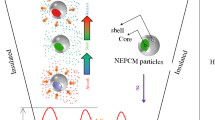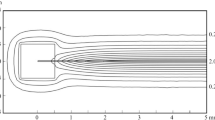Summary
While the theory concerning critical discharges of single-phase flow, in particular of gases, is well known, the direct opposite is true for two-phase mixtures. The question still remains to be answered whether critical flow occurs for two-phase flow with the same implications that it carries for single-phase flow. A theoretical analysis, which is supported by experimental data, is presented in this paper and indicates that the implications for single-phase and two-phase critical flow differ significantly. While single-phase flow is restricted by so-called sonic choking, the extra freedom available in a two-phase flow system, the slip ratio, restricts the maximum flow in the latter. Furthermore, two-phase critical flow is achieved when the slip ratio takes on a value such that the rate of momentum gain by convection per unit volume becomes identical in each fluid phase.
Similar content being viewed by others
Abbreviations
- A :
-
cross-sectional area of flow, ft2
- D :
-
equivalent diameter or diameter of test section, ft
- f :
-
friction factor, dimensionless
- G :
-
mass flow rate, lb m /sec-ft2
- g :
-
gravitational constant, 32.2 ft/sec2
- g c :
-
conversion factor, 32.2 lb m -ft/lb f -sec2
- k :
-
ū 2/ū 1, slipratio, dimensionless
- p :
-
static pressure, lb f /ft2
- t :
-
time, sec
- ū :
-
average velocity, ft/sec
- v :
-
specific volume, ft3/lb m
- W :
-
mass rate, lb m /sec
- x :
-
length in direction of flow, ft
- α :
-
void fraction, dimensionless
- ρ :
-
density, lb m /ft3
- τ :
-
shear force, lb f /ft2
- χ :
-
quality, dimensionless
- i :
-
refers to the i-th phase
- k :
-
refers to the k-th phase
- n :
-
refers to the number of phases
- 1:
-
refers to liquid phase
- 2:
-
refers to vapor phase
References
Isbin, H. S., J. E. Moy and J. R. DaCruz, A.I.Ch.E. Journal 3 (1957) 361.
Faletti, D. W., Two-Phase Critical Flow of Steam-Water Mixtures, Ph.D. Thesis, Univ. of Washington, 1959.
Zaloudek, F. R., The Low Pressure Critical Discharge of Steam-Water Mixtures from Pipes, HW-68934, 1961.
Muraoka, J., Steam-Water Critical Flow Test-Design Test 1040, HW-69488, 1961.
Fauske, H. K., Contribution to the Theory of Two-Phase, One-Component Critical Flow, Dissertation in partial fulfillment of ScD. degree, 1961.
Fauske, H. K., Critical Two-Phase, Steam-Water Flows, 1961 Proc. Heat Transfer and Fluid Mech. Inst., Stanford University Press.
Author information
Authors and Affiliations
Additional information
Work performed under the auspicies of the U.S. Atomic Energy Commission.
Rights and permissions
About this article
Cite this article
Fauske, H.K. Some ideas about the mechanism causing two-phase critical flow. Appl. sci. Res. 13, 149–160 (1964). https://doi.org/10.1007/BF00382043
Received:
Issue Date:
DOI: https://doi.org/10.1007/BF00382043




